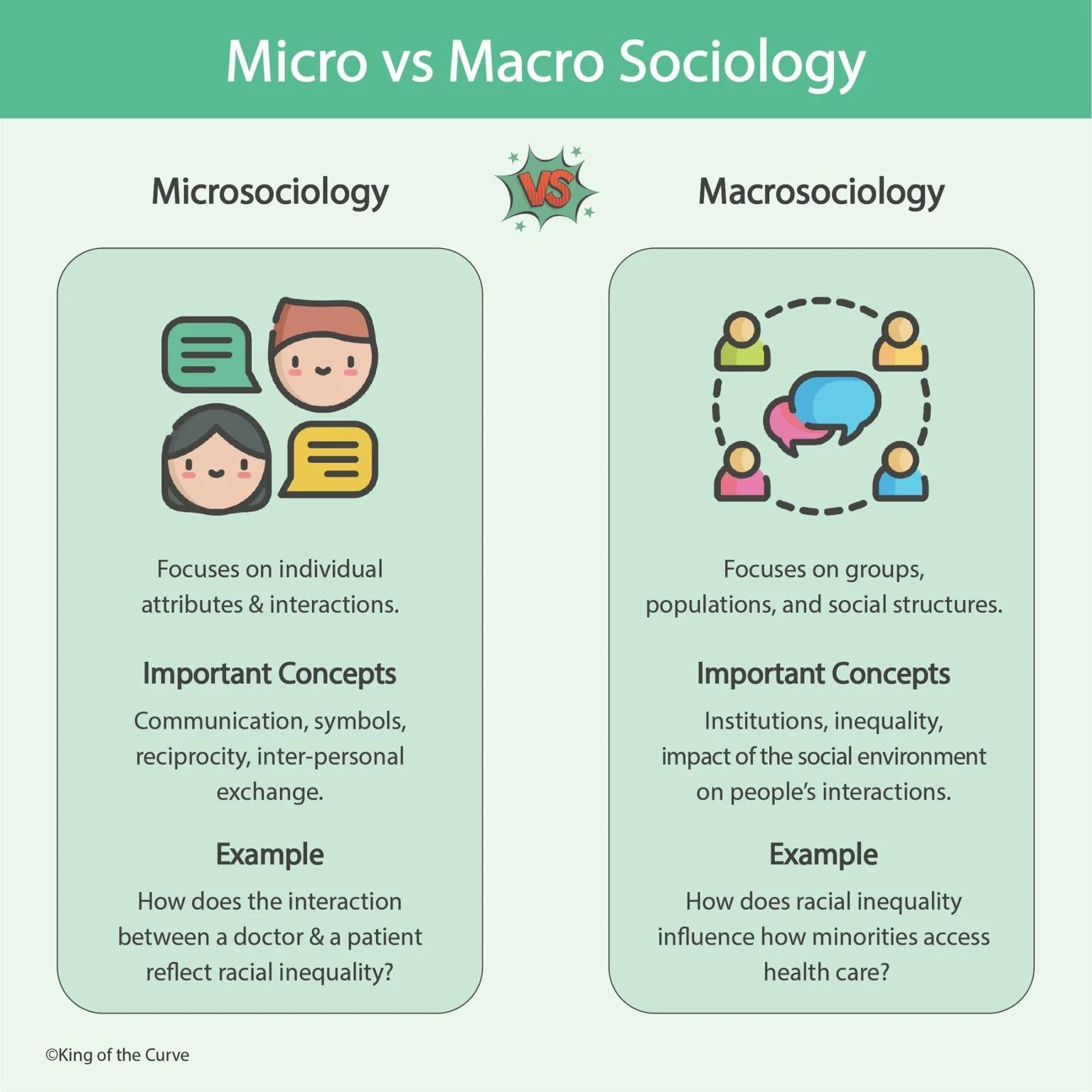🧠 Micro vs. Macro Sociology: Understanding Society from Two Perspectives
Sociology gives us the tools to understand human behavior — from one-on-one interactions to global institutions.
For MCAT and NCLEX test-takers, mastering the difference between microsociology and macrosociology is essential. These perspectives help explain how individuals and societies shape each other, influencing everything from healthcare to social policy.
👥 Microsociology: The Study of Individuals and Small Groups
Microsociology zooms in on the small-scale social interactions that make up everyday life. It explores how meaning, communication, and personal dynamics form the foundation of society.
Key Ideas:
Focus: Individual attributes, relationships, and communication
Important Concepts: Symbols, language, reciprocity, interpersonal exchange
Typical Question: How do micro-level actions reinforce or challenge larger social systems?
Example (MCAT Style):
“How does the interaction between a doctor and a patient reflect racial inequality?”
This type of question tests your understanding of symbolic interactionism — a major microsociological theory emphasizing shared meaning and perception in social interactions.
🌍 Macrosociology: The Study of Systems and Structures
Macrosociology takes a big-picture view, examining how large-scale social systems — such as institutions, governments, and economies — influence groups and individuals.
Key Ideas:
Focus: Groups, populations, and overarching structures
Important Concepts: Institutions, inequality, and the impact of social environments
Typical Question: How do societal systems maintain or disrupt equity?
Example (MCAT Style):
“How does racial inequality influence how minorities access healthcare?”
This reflects macrosociological theories like conflict theory (power and inequality) and structural functionalism (how social systems maintain stability).
📊 Quick Comparison: Microsociology vs. Macrosociology
| Feature | Microsociology | Macrosociology |
|---|---|---|
| Focus | Individuals and small groups | Large groups and social institutions |
| Scale | Micro-level (face-to-face) | Macro-level (societal and global) |
| Key Theories | Symbolic interactionism, social exchange theory | Functionalism, conflict theory |
| Example Question | How does communication build social meaning? | How do institutions perpetuate inequality? |
| Exam Application | MCAT passages on physician–patient interactions | MCAT/NCLEX questions on healthcare systems or policy |
🎓 Exam Relevance
🧩 For the MCAT
Understanding micro vs. macro helps in sociology and psychology passages, especially those that link individual behaviors to systemic outcomes.
Micro = person-level understanding
Macro = society-level structure
🏥 For the NCLEX
These perspectives guide how nurses and healthcare professionals approach patient care and public health — seeing both personal communication and institutional barriers in healthcare delivery.
💡 Why Visual Learning Works
At King of the Curve, we believe complex concepts should be simple to see and easy to remember.
Our visuals, like “Micro vs. Macro Sociology”, help you:
Compare theories side by side
Retain content longer
Connect abstract ideas to real-world examples
With over 100,000 downloads, our platform combines adaptive Q-banks, gamified learning, and interactive visuals to make studying both efficient and enjoyable.
🚀 Call-to-Action
Want to master sociology and psychology the visual way?
👉 Explore 1,000+ science and social science visuals at mcat.kingofthecurve.org
👉 Get daily practice at kingofthecurve.org/qotd
👉 Join our Free Lifetime Access program at kingofthecurve.org/free-lifetime
Frequently Asked Questions (FAQs)
-
Aim for 4-6 focused hours, ensuring you incorporate breaks to avoid burnout.
-
Practice mindfulness techniques, take practice exams under realistic conditions, and maintain a balanced lifestyle.
-
Set short-term goals, seek support from mentors, and reward yourself for small achievements.
-
Regular exercise improves focus, reduces stress, and enhances overall mental clarity.
-
KOTC offers personalized learning tools, gamification features, and adaptive question banks to help students stay on track without burnout.


